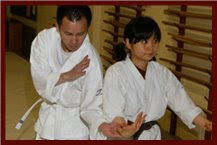Vince Sensei recently taught two classes in conflict resolution at the Nevada Museum of Art—emphasizing Listen, Apologize, Solve, and Thank (LAST). Museum employees were eager to discuss situations in which conflict had arisen between patrons and staff. They identified examples including parents allowing children to touch art objects and unwillingness of patrons to check personal belongings at the door. Sensei explained “LAST” so that participants would understand it intellectually, followed by using the approach in role-playing to also learn it experientially.
Verbal interaction was the theme of the first class. Sensei said that most people just want to be heard. To communicate this effectively, he advised, “Listen and repeat back what you heard.” Second, apologize to the person for the difficulty they are experiencing followed by asking questions and offering approaches to solve the problem. Most people agreed with Sensei that they don’t like being told what to do. Finally, thank the person for bringing the situation to light and allow them to save face by expressing appreciation for their concerns. Sensei used a quiet, calm tone of voice in each example—making the case that the manner of speaking is as important as word choice. If he raised his voice in argument with the other person, it increased defensiveness and exacerbated conflict.
The second class focused on physical aspects of conflict. Sensei made the point that humans communicate with body language and gestures as much as words. We read great meaning into these gestures, even if only subconsciously. If words and body language are at odds, the words will not seem sincere. Sensei showed that different postures when standing or different ways of placing our hands or heads indicate openness, friendliness, or attentiveness to others. Conversely, looking down or standing with arms folded can be a barrier to communication, while approaching too quickly or closely can signal aggression and provoke fear or anger. The students practiced different postures and facial expressions with each other and described how they felt in response. For example, a simple change in the amount of space between people had a definite impact on their comfort level.
In the case of physical aggression—such as someone attempting to strike another —museum employees had the chance to experience the aiki way of not blocking or fighting the person’s force, but rather circling around the power and neutralizing the attack without anyone getting hurt. Sensei demonstrated this with members of Aikido of Reno.
A key message of the classes was that everyone has been in conflict situations, both verbal and physical, and they are often not handled successfully. The conflict resolution techniques taught by Sensei can apply in many cases, and these skills help people become more successful in the world of work or personal relationships. Sensei said that being non-confrontational isn’t the same as being a pushover. LAST means remaining firm yet flexible in conflict situations—creating a win-win outcome for all.
Subscribe to:
Post Comments (Atom)




No comments:
Post a Comment